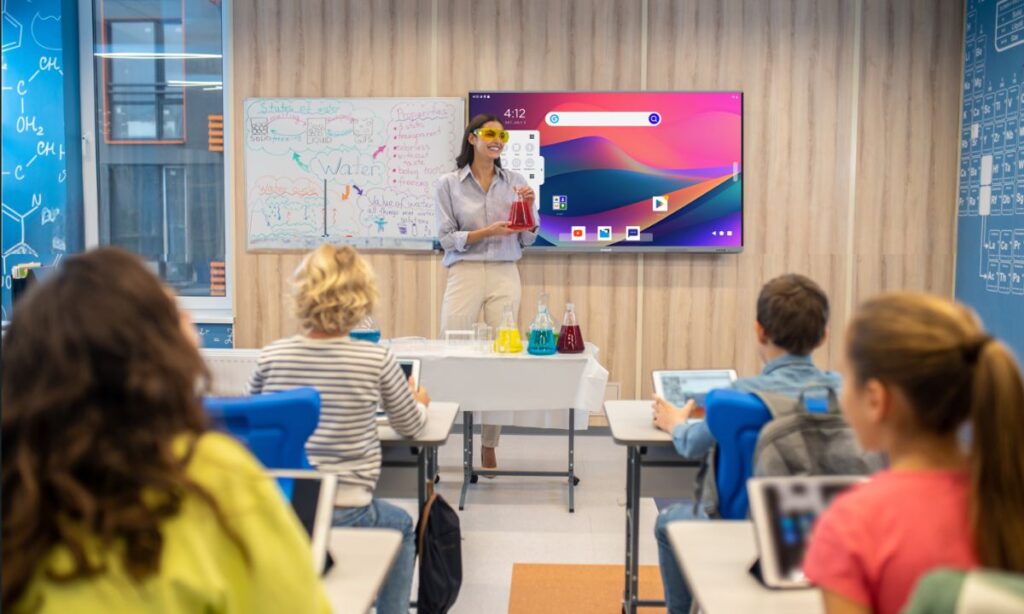Interactive whiteboard (IWB) are more than just a teaching tool. They are a platform for collaboration, creativity, and engagement in the classroom. IWBs are digital displays that allow teachers and students to interact with various types of content, such as images, videos, documents, and web pages. IWB can also be used to record and share lessons, create interactive presentations, and facilitate group work.
1. Increase student motivation and participation
One of the main benefits of IWBs is that they can increase student motivation and participation in the classroom. IWBs can make learning more fun and interactive by allowing students to use touch, gestures, and digital tools to manipulate and explore content. IWBs can also provide instant feedback and reinforcement, which can boost student confidence and self-esteem.
2. Support different learning styles and needs
Another benefit of IWBs is that they can support different learning styles and needs of students. IWBs can cater to visual, auditory, and learners by offering various modes of presentation and interaction. IWBs can also help teachers to differentiate instruction and provide personalized materials to help students understand concepts better.
3. Enhance teacher effectiveness and efficiency
IWBs can also enhance teacher effectiveness and efficiency by saving time and resources. IWBs can help teachers to prepare and deliver lessons more easily by allowing them to upload and access existing resources, such as PowerPoint presentations, PDFs, documents, and files. IWBs can also help teachers to monitor and assess student progress and performance by using features such as quizzes, polls, and annotations.
4. Promote creativity and innovation
IWBs can also promote creativity and innovation in the classroom by allowing teachers and students to create and explore new content and ideas. IWBs can enable teachers and students to use digital tools, such as drawing, writing, and editing, to express their thoughts and opinions. IWBs can also enable teachers and students to access and integrate various sources of information, such as images, videos, web pages, and apps, to enrich their learning.
5. Foster collaboration and teamwork
IWBs can also foster collaboration and teamwork in the classroom by allowing teachers and students to work together on group activities and projects. IWBs can facilitate group work by enabling teachers and students to share and edit content on the same or different devices. IWBs can also facilitate group work by enabling teachers and students to communicate and interact with each other through voice chat and collaborative sessions.
6. Improve digital literacy and skills
IWBs can also improve digital literacy and skills of teachers and students by exposing them to various types of technology and media. IWBs can help teachers and students to develop and practice skills such as research, critical thinking, problem-solving, and communication.
7. Support curriculum and standards alignment
IWBs can also support curriculum and standards alignment by helping teachers and students to meet the learning objectives and outcomes of their courses and subjects. IWBs can help teachers and students to align their content and activities with the relevant curriculum and standards, such as Common Core, Next Generation Science Standards, and International Society for Technology in Education. IWBs can also help teachers and students to prepare and perform better on standardized tests and assessments by providing practice and feedback.
8. Enhance cross-curricular and interdisciplinary learning
IWBs can also enhance cross-curricular and interdisciplinary learning by helping teachers and students to connect and integrate different topics and disciplines. IWBs can help teachers and students to explore the connections and relationships between various subjects, such as math, science, language arts, and social studies.
9. Increase student autonomy and ownership
IWBs can also increase student autonomy and ownership by helping students to take more control and responsibility of their own learning. IWBs can help students to set their own goals and pace, choose their own content and activities, and monitor their own progress and performance.
10. Inspire lifelong learning and curiosity
IWBs can also inspire lifelong learning and curiosity by helping teachers and students to develop a passion and interest for learning. IWBs can help teachers and students to discover new topics and areas of interest, expand their horizons and perspectives, and pursue their hobbies and passions. IWBs can also help teachers and students to keep up with the latest trends and developments in technology and media, and to adapt to the changing needs and demands of the 21st century.
Conclusion
Interactive whiteboards are a powerful and versatile tool that can bring many benefits to teaching and learning. IWBs can increase student motivation and participation, support different learning styles and needs, enhance teacher effectiveness and efficiency, promote creativity and innovation, foster collaboration, and teamwork, improve digital literacy and skills, support curriculum and standards alignment, enhance cross-curricular and interdisciplinary learning, increase student autonomy and ownership, and inspire lifelong learning and curiosity. By integrating interactive whiteboards in teaching, teachers and students can transform their classroom into a dynamic and engaging learning environment.






